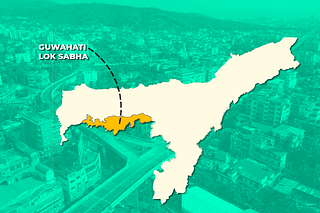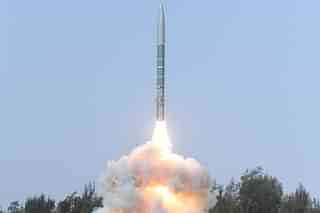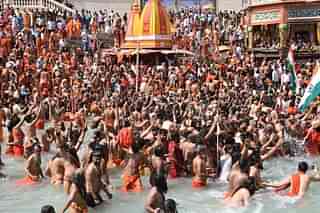Ideas
Audrey Truschke Says Mughal Emperor Aurangzeb Protected Hindu Temples, But Here’s A Record Of His Rule
M R Subramani
Jan 15, 2021, 03:50 PM | Updated 03:49 PM IST
Save & read from anywhere!
Bookmark stories for easy access on any device or the Swarajya app.

Audrey Truschke, author of the book Aurangzeb: The Man and Myth, has once again triggered a controversy over Mughal Emperor Aurangzeb, saying he protected more Hindu temples than he destroyed.
In a review on her book on Aurangzeb, Swarajya had in 2017 recommended against buying the book, saying it would be better to borrow from a friend and read it.
In a response on Twitter, Truschke, as associate professor of history at Rutgers University-Newark, has said that the controversial Mughal emperor’s twin policies of protecting and destroying temples had worked.
To a debate that Gyanvapi Mosque in Varanasi is the biggest annihilation of Hindus by Aurangzeb, the history associate professor argues that the rage is borne out of ignorance.
Truschke, however, has not given any clear response to that argument, dismissing it at “Your problem is not with me but, rather, with history”.
Aurangzeb’s treatment of Hindus have been etched out clearly by R S Narayanaswami in his Tamil book Bharatha Desa Charithram, which has been translated into English Beyond the Veil - The History of Bharat Varsha.
The author quotes Maasir-I-Alamgiri, a history of Aurangzeb, on how the Mughal emperor ordered all governors to demolish all temples and patshalas on 9 April 1669.
Based on the order, temples were demolished and reports sent to him. A report that Aurangzeb received on 2 September 1669 said: “Officials had demolished the Kashi Vishwanath temple”.
Aurangzeb’s attitude towards people of other faith was evident even before he took over from Shah Jahan.
When Golconda King Abul Hasan alias Tana Shah (1672-87) handed over the administrative responsibilities to his prime minister Madanna, Aurangzeb tried to invade the kingdom but Shah Jahan halted it.
Thirty years later, however, Aurangzeb returned to Golconda to capture it. The reason for Aurangzeb raiding Golconda was a Hindu, Madanna, was made the prime minister, though Hasan's vices also angered him.
It is another matter that Aurangzeb had to bribe the Golconda general to take over the city before killing Madanna and his brothers.
On the other hand, the Mughal emperor imprisoned the Golconda sultan compared to his treatment of Madanna.
Narayanaswami says that during his reign, Aurangzeb enacted a new law every year for the first 20 years to harass Hindus.
In 1659, he punished kind-hearted Muslims and assassinated a mullah called Sarmad for being kind to his brother Dara Shikoh. In 1659, he barred Hindus from constructing new temples before barring even reconstruction of old temples in 1664.
In 1665, he imposed toll taxes on Hindus and two years later, he declared that Muslims need not pay toll taxes. Music was banned in 1668 and Hindu temple festivals were not allowed.
In 1669, Aurangzeb ordered the governors to demolish temples in their regions. He also ordered supervision of the demolitions. Temples in Kashi and Mathura were razed to the ground. Deepavali, Durga Pooja and Shias’ Muharram festivals were banned.
In 1670, the Mughal emperor made it mandatory to say “Salaam alaikum” (peace be unto you) in the sultan’s court and from the next year, only Muslims were given the job of collecting taxes. He made it clear that Hindus would not be assigned the job.
In 1679, jizya (tax) was mandatorily collected from Hindus and violent methods were used for tax collection.
Aurangzeb also ordered that Hindus should not travel in palanquins and that no Hindu practice be followed in his court.
He ordered the conversion of Hindus to Islam and those who converted themselves were given government and defence jobs. Those who could not pay Jizya had to compulsorily convert themselves to Islam.
Narayanswami says that Italian writer and traveller Niccolao Manucci was baffled to witness these incidents.
When Hindus resented the Jizya tax in 1679, gathered in front of Aurangzeb’s palace pleading for its withdrawal.
A week later, on a Friday, Hindus stood on the street normally used by Aurangzeb to go to Juma Masjid and to again request him to scrap jizya.
Aurangzeb was unmoved. He warned the people of dire consequences and let loose his elephants to stomp the crowd.
Aurangzeb has also given a list of temples he has demolished or razed to the ground by him. Narayanaswami says the list was provided by the Mughal emperor himself.
The temples that were demolished or razed were Cooch Behar temples, the temple constructed by Udaipur Maharana, the Mewar Someshwar temple, the Hatkeshwar temple, Bijapur temple and the Pandharpur temple.
In many of these places, he ordered his governors to construct mosques in the place of the temples that were demolished. That is how the Gyanvapi mosque was built in Varanasi.
No one is sure from where Truschke has got her facts on history but the truth is that many wanting to know more of Indian history seem to rely on the Westerners’ impression rather than look deeper into the country’s own resources.
This, according to Narayanaswami, has led to Indian history being misrepresented.
Disclaimer: The author has translated Narayanaswami’s book Bharatha Desa Charithram from Tamil to English Beyond the Veil - History of Bharatavarsha along with Aiyasami Uthandaraman.
Save & read from anywhere!
Bookmark stories for easy access on any device or the Swarajya app.
M.R. Subramani is Executive Editor, Swarajya. He tweets @mrsubramani
Support Swarajya's 50 Ground Reports Project & Sponsor A Story
Every general election Swarajya does a 50 ground reports project.
Aimed only at serious readers and those who appreciate the nuances of political undercurrents, the project provides a sense of India's electoral landscape. As you know, these reports are produced after considerable investment of travel, time and effort on the ground.
This time too we've kicked off the project in style and have covered over 30 constituencies already. If you're someone who appreciates such work and have enjoyed our coverage please consider sponsoring a ground report for just Rs 2999 to Rs 19,999 - it goes a long way in helping us produce more quality reportage.
You can also back this project by becoming a subscriber for as little as Rs 999 - so do click on this links and choose a plan that suits you and back us.
Click below to contribute.





